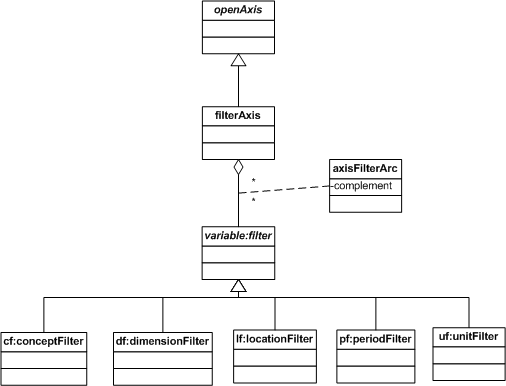1 Introduction
This document specifies semantics and syntax constraints for filter axes. Filter axes provide an implementation of open axes, as defined in the table specification, based on the use of filters.
2 Namespaces and namespace prefixes
Namespace prefixes [XML NAMES] will be used
for elements and attributes in
the form ns:name where ns is the
namespace prefix and name is the local name.
Throughout this specification, the mappings
from namespace prefixes to actual namespaces are consistent
with Table 1.
The prefix column in Table 1 is non normative. The namespace URI column is normative.
| Prefix | Namespace URI |
|---|---|
table
|
http://xbrl.org/2011/table
|
xbrlte
|
http://xbrl.org/2011/table/error
|
link
|
http://www.xbrl.org/2003/linkbase
|
xbrli
|
http://www.xbrl.org/2003/instance
|
xfi
|
http://www.xbrl.org/2005/function/instance
|
xbrldi
|
http://xbrl.org/2006/xbrldi
|
xbrldt
|
http://xbrl.org/2005/xbrldt
|
xl
|
http://www.xbrl.org/2003/XLink
|
xlink
|
http://www.w3.org/1999/xlink
|
xs
|
http://www.w3.org/2001/XMLSchema
|
xsi
|
http://www.w3.org/2001/XMLSchema-instance
|
generic
|
http://xbrl.org/2007/generic
|
3 Definitions
The figure below provides a model of the filter axis.

A filter axis is an implementation of open axes expressed in terms of variable filters. Those variable filters are associated to the axis through axis-filter relationships.
4 Aspect Constraints
A fact corresponds to a coordinate of a filter axis if it satisfies every filter associated to its own disposition of axis, for that subset of the facts that satisfy or correspond with any preceding axes of the same axis disposition, and that satisfy the coordinates of axes of the other dispositions, and all other predefined coordinates for the cell being rendered.
The aspects covered by a filter axis are the aspects covered by its filters . (The concept of aspect-covering as noted in the variables specification applies to implicit filtering for binding facts to variables of a variable set, and in this specification applies to designating the aspects covered by an axis, for determination of axis aspect coverage conflicts.)
An axis filter cannot be associated to filters that do not cover an aspect.
Error code xbrlte:axisFilterCoversNoAspects
MUST be thrown
if the processing software encounters a filter in a filter axis that covers no aspects.
5 Headers
Headers of the filter axis are represented by the set of XLink resources in a generic linkbase. They can be associated to generic labels or messages, and generic references. These labels, messages, and references SHOULD be used as labels and references of the headers by a rendering engine. Labels, messages, and references are used in the normal manner of such linkbases, ignoring the link role labels and references.
Usually a filter axis provides a dynamically determined set of columns for which a static label association does not make sense,
but instead a message may be associated. Then a typed dimension could use the message’s formatting capabilities.
The message context item is bound to one (or more) facts that meet the filter constraints.
Thus the message could provide a desired label for a dimension qname value, a typed dimension contents, or period coordinate.
6 Syntax
A filter Axis is represented by a <table:filterAxis> element with one or more <variable:filter> resources related by axis filter arc relationships.
The <filterAxis> may have @value XPath expressions. The context item for each XPath expression is the fact bound to coordinates of each
axis, or the selection Axis result when applicable (when bound to coordinates of a cell). XPath expressions may refer to parameters and
selection Axes by name, when in effect. The filterAxis may also specify a @format transform, @scale, and @negate, which apply to the
fact value to be displayed, after result of any @value expression if present.
6.1 Axis-filter relationships
A axis-filter relationship
is a relationship between an
<table:filterAxis>
and a <variable:filter>
expressed by an XLink arc.
To declare an axis-filter relationship an XLink arc MUST:
-
have an
arcrole value
equal to
http://xbrl.org/arcrole/2011/axis/axis-filter -
have an
<table:filterAxis>element at the starting resource of the arc - have a filter at the ending resource of the arc
The arcrole value,
http://xbrl.org/arcrole/2011/axis/axis-filter,
is declared in the normative schema supplied with this specification.
Axis-filter relationships MUST be expressed by axis-filter arcs. Violations of this requirement can be detected by validation against the XBRL Specification [XBRL 2.1].
A complemented axis-filter relationship is an axis-filter relationship
that is expressed by an arc with a @complement attribute that has a value of true.
A filterAxis with a complemented axis-filter relationship to a filter uses the filter complement in its implied XPath expression rather than the filter itself.
A covering axis-filter relationship is a axis-filter relationship
that is expressed by an arc with a @cover attribute that has a value of true.
If a filter is related to a variable by a variable-filter relationship, that filter only covers aspects of the facts being filtered if the variable-filter relationship is covering.
6.1.1 Axis-filter arcs
A axis-filter arc is expressed by
the <table:axisFilterArc> element.
The syntax for the
<variable:axisFilterArc>
element is defined by the normative schema supplied with this specification.